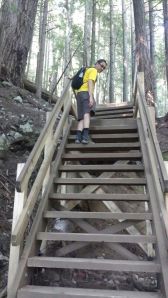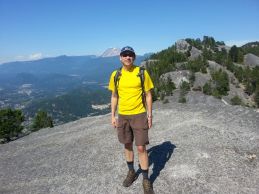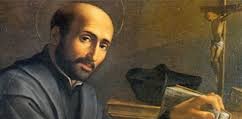By Dom Bautista Vancouver Jesuit Alumni Group
Mother Cabrini tickets
There he was …. in the hot July 31 evening with not a care in the world but just being happy. The image of Guillermo Gregorio (GG) Francisco standing at the entrance to St. Marks will forever be etched indelibly in my mind. Resplendent in his barong tagalog (the Philippine dress worn on special occasions), smiling as he always does, and handing out tickets for all so that we could find a parking spot. It was an act of sublime intercession by Mother Cabrini, the patron saint of parking lots. It turns out Mother Cabrini told him that because I spilled his secret to the JAG, there were far too many requests for parking spots that he should go early. That Fr Rob Allore, SJ would gift GG with a stack of tickets (biglietti) to hand out was the second gift from Mother Cabrini to him!
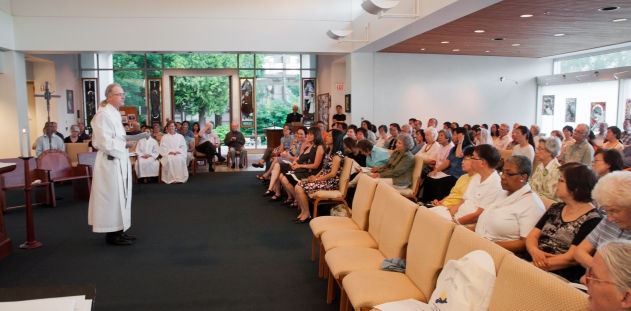
Fr Rob Allore SJ celebrates St Ignatius Feast Day to a full house at St Mark’s church on July 31, 2014.
Doing the jig
On St Ignatius Day, July 31, 2014, members of the Vancouver Ignatian family – comprised of the Jesuit Spirituality Apostolate of Vancouver, the Jesuit Alumni Group, the three Christian Life Community groups (Lighthouse, St Augustine, St Mark’s) and the Society of Evangelical Life of the Heart of Jesus – met for a Mass presided over by Father Rob Allore, SJ. Following the Mass, several members of this group spoke. Here are the remarks made by Dom Bautista of the Jesuit Alumni Group.
Have you ever seen a priest do a jig? Right before starting mass? Well, that is exactly what Fr Rob did. That it was to be his third mass for the day, did not diminish his exuberance and glow in his face; perhaps it was because of the well over a hundred people that day. That he managed to craft a beautiful homily, using a God-less story from the CBC to illustrate how one can find God in the most unusual places was very touching. So Ignatian!
My 20,000 Words
I want to thank Fr Rob for welcoming us for a second year. The preparation of this event was made possible by the help of St Mark’s Parish and the members of the Ignatian family comprised of the Jesuit Spirituality Apostolate of Vancouver, the three Christian Life Community groups (Lighthouse, St Augustine, St Mark’s) and the Society of Evangelical Life of the Heart of Jesus.
Having just listened to Catherine Kelly, it is quite obvious that JSAV have picked the best to represent them. Our Jesuit Alumni Group however, decided to take a different approach, for they saw it fit to ask the least qualified member to speak on their behalf today …. me. Because I made the mistake of not being in the room when they made these assignments.
What began in a year and a half ago as an invitation from Fr Robert Wong, led to a meeting with Provincial Superior of the Jesuits in English Canada Fr Peter Bisson one winter’s night. He suggested that the Jesuit alumni might consider meeting once a year. Under the leadership of Eric Ching, we have been meeting monthly from the start. He has since retired from leading the group and acts as an elder.
As we seek to discern Christ’s voice in our daily lives, our spiritual exercises have been focused and reflective, punctuated by laughter. Our lives have been enriched as we have rediscovered ways to move towards consolation, such that we are able to pay closer attention to His subtle voice, to appreciate grace and to accept faith as a gift and most importantly, as a choice.
Through our fellowship, we share our worries, our doubts, and shortcomings with one another. Our connections extend beyond the Saturday morning meetings, I know many an evening when I have written them to ask for prayers. And they have been generous.
It is also through our fellowship that we have deepened our appreciation of the saints in our daily lives. We know of St Anthony the patron saint of all things lost from keys, to files and for me …. my memory. Last night, Ken had to ask St Anthony to remind me of the small outreach project that we did in St. Teresa’s Parish, in the village of Tang Qui, Hebei China.
We have been blessed with two spiritual directors. Fr Elton Fernandes, SJ who is now in Melbourne, and Fr Richard Soo, SJ. Our journey with Fr Richard has taken us to a new level. You see, aside from being a Jesuit, he is also a Byzantine priest. So our education has been enriched with our introduction to Eastern rites.
This year the alumni have began blogging – a modest project that allows us to share our reflections in English, Chinese, French and Tagalog. It is very fitting that our first entry was about the lighting of the chrism of the Jesuit society and to share our Ignatian values. My friends, as I look at all of you in this room, your presence here today, tells me that our prayers have been answered. Thank you for being here to celebrate with us.
Apart from facilitating today’s feast, the JAG also hosts a retreat for you, the Ignatian community. This years’ retreat takes place on September 6 at the Eastern Catholic Church in Richmond. Fr Richard will be our retreat master. At this time, I would like to ask this year’s three heads: Ignatius Lee, David Tong and Georges Gracieuse to stand. If any of you are interested in our monthly get togethers or about the upcoming retreat, please see them.
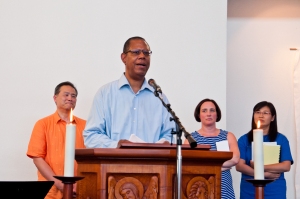
As Georges Gracieuse speaks, Dom Bautista (left) and Catherine Kelly (right) and a member of the Christian Life Community look on.
At the conclusion of todays’ celebration, there will be some snacks and refreshments. Thank you Janice and Christine for helping us prepare a sumptuous meal. Thank you Kevin for leading us in the music. And for making us sound like angels.
Finally, if any of you would like to join us in a different kind spiritual exercise, please see GG, as we are heading a pub on campus later this evening.
Ad Majorem Dei Gloriam!
JAG blogs can be read in English, Chinese, and French at: jagvancouver.wordpress.com
修女給予之停車証
在七月卅一日一個炎熱的黃昏、他……..一片喜悦、對世事全無牽掛的站在那裡。
這人就是Guillermo Gregorio (GG) Francisco。他站在 St. Mark’s 教堂入口處那影像深深的刻劃在我腦海𥚃:他、穿上繡花的菲律賓禮服、容光煥發、帶着慣常的笑容、迎接每個到步的人、向他們派發停車証。
這景象一定是停車場主保聖人 Mother Cabrini 代禱的崇高傑作:我把 GG 趣味性的秘密告訴了 JAG、所以今天聚會引來很多參與者。因為人多、Mother Cabrini 便着 GG 早些到場以免他找不着車位。Mother Cabrini 更假耶稣會神父 Fr. Rob Allore SJ 的手送了大量停車証給 GG , 好待他發放給各參與者。
土風舞表演
你有見過神父表演土風舞嗎、而且是在舉行彌撒之前? Fr. Rob 便做到了!那天 Fr Rob 已是第三次舉行彌撒了、但他仍是精神飽滿光釆依然的;這可能是那超過一百參與的信眾給予他的鼓舞。Fr. Rob 說了一篇很感人的道理;他借用了一個 CBC 沒有提及天主的故事來告訴我們怎樣在一些非尋常的角落裡也能找到上主。 這確實是一個耶穌會聖依納爵的傳道方法!
彌撒禮成後、Fr. Rob 更讓我們幾個團體的代表發言。
我的二萬字….
多 謝 Fr. Rob 今次第二年再歡迎我們。是次活動之能夠成功舉辦、要多謝 St. Mark’s 堂區和聖依納爵家庭各成員、包括 Jesuit Spirituality Apostolate of Vancouver, the three Christian Life Community groups (Lighthouse, St Augustine, St Marks) 和 Society of Evangelical Life of the Heart of Jesus.
剛才聽了 Catherine Kelly 的發言、就知道 JSAV 派了一位出色的代表。反之我們的耶穌會舊生會卻採取別一方案、派了一位資格最底微的人作為發言人。因為那天選代表的時候我不在場、它們就選了我!
一 年半前、藉 Fr. Robert Wong 黃神父的邀請、在一個冬天晚上我們得以與 Jesuit in English Canada 省長 Fr. Peter Bisson 會面。Fr. Bisson 建議我們的耶穌會舊生會毎年聚會一次。但在 Eric Ching 莊怡立先生的領導下、我們一開始就每月聚會一次。如今 Eric 已退出領導層作為舊生會的元老。
在日常生活中、要辨識基督的指引、我們的靈修要集中、要時常反思、更要放寬、要帶歡笑。當我們重新找到安慰、我們的生活更添豐采。除之、我們更能留意上主的啓示、更感恩、更覺信徳不只是禮物、亦是一個選擇。
在各友誼聚會中、我們分享我們的憂累、我們的疑問、我們的缺點。我們的聯繫不只限於每星期六早上的聚會。有多個晚上我曾要求大家為我的需要祈禱時、他們亦慷慨幫忙。
我們亦在聯誼中對於我們日常生活裡的聖人加深了認識。如眾所知:聖安東尼是失物的主保聖人。他不知幫過我多少次….我失去的鑰匙、公文件、甚至我的記憶!看!昨晚 楊思傑先生又勞煩聖安東尼提醒我們在中國河北省宁晋縣唐邱天主堂所做之外展傳道項目。
我們對有兩位神父作為我們的神師感到榮幸:這兩位神師就是 Fr Elton Fernandes SJ 和 Fr Richard Soo SJ。 Fr Elton 現去了澳洲墨爾本。Fr Richard 因為除了是耶穌會會士,亦是拜占庭基督宗教神父、他令我們認識到傳統東方的教會儀式、加深了我們的知識。
今年我們的耶穌會舊生會開始用微博討論、一個雛形的項目:用英、中、法和菲律賓四種語文來分享我們的思維。第一步論題最貼切不過的便是如何點亮耶穌會的聖油和分享聖依納爵的理念。當我見到你們的熱誠參與、我便知上主已聽到和回應我們的祈求。多謝各位。
除了今日的曕禮、JAG 更為整個聖依納爵團體舉辦靈修避靜活動。今年的避靜日在 九月六日在Richmond 之Eastern Catholic Church 舉行、由 Fr Richard 引領。現在、我請我會的三個主持人站起來讓各位認識:Ignatius Lee 李偉國先生, David Tong, George Gracieuse。各位有興趣參加我們的月會或避靜、請與仼何一位主持人聯絡。
今日散會前、我們有少許茶點招待大家。在此多謝 Janice, Christine 替我們預備這豐富的美食。亦多謝 Kevin 為我們作音樂領導。令我們的聲韻好比天使的美妙!
如各位有什麼其他神修活動提議、請告之 GG。
愈顯主榮
各教友可上 jagvancouver.wordpress.com 瀏覽 JAG 英、法、中、菲律賓文「博客」。

